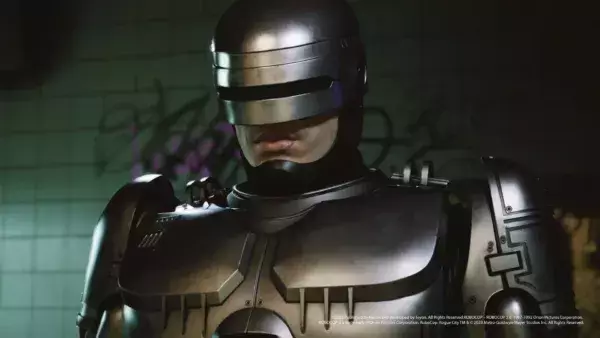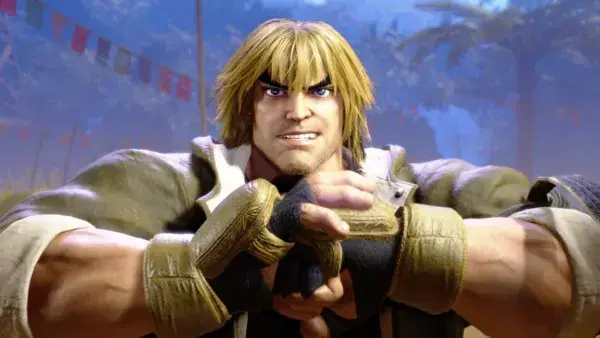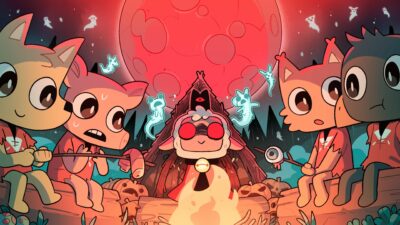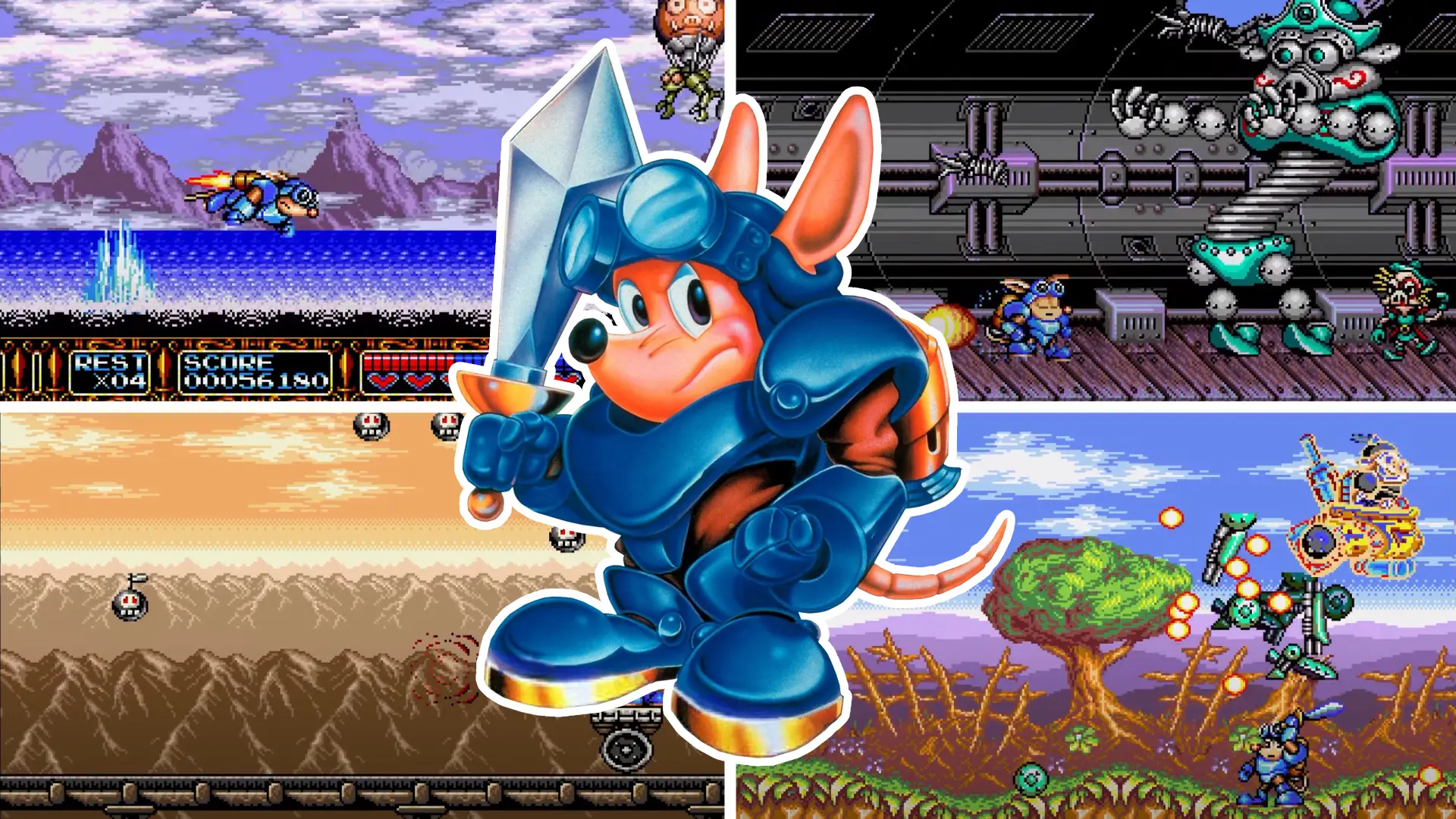
In 1993, Konami launched its own Sonic-killer, a flying, sword-wielding opossum with attitude named Sparkster. So why did Rocket Knight never quite take off?
Retro gaming has many pleasures, but not everything was better in the old days. One of the worst horrors of the 16-bit era was the so-called ‘Sonic Boom’ of dire, hastily-designed ‘Mascots With Attitude’ rushed out to cash in on the Sonic mania of the early 1990s Mega Drive generation.
Sega’s cute blue figurehead, if you remember, wore sneakers, adopted a wry smile and wagging finger, and was, for want of a better term, “totally radical”, whatever that actually means (only Bill & Ted know). Cue a rash of low-rent western rip-offs, ranging from Bubsy the Bobcat to Aero the AcroBat, Zool the Ninja Ant, James Pond RoboCod, Punky Skunk, Rocky Rodent, Zero the Kamikaze Squirrel and even a game based around Colin Curly, the cartoon dog in a yellow suit from the front of old Quavers packets (with able assistance from G.I. Ant the Giant Ant: I’m not making this up).
Some such characters, it’s my sad duty to inform you, even went so far as to wear backwards-facing baseball caps.
Read more: Konami’s forgotten knock-off Indiana Jones game
Recycled rubbish
Perhaps the most notorious mascot with attitude was Awesome Possum, of 1993 Mega Drive 2D platformer Awesome Possum… Kicks Dr Machino’s Butt, where ‘Dr Machino’ was clearly based on Dr Robotnik from Sonic. Awesome Possum, it seems, is actually an obscure US slang term meaning ‘very good indeed’, which by all accounts the game itself was not. If only the English language had contained such terms of excess approbation as ‘Incredible Badger’, ‘Top Mole’ or ‘Marvellous Mongoose’ instead, video gaming history could have been very different.
Although it gained some decent reviews at the time, Awesome Possum is now considered a byword for generic mid-90s platforming tat. Billed dubiously by its US developers Tengen as “an excellent educational game for all ages”, it posed as having an environmentalist message like Sega’s Ecco the Dolphin, with the titular possum collecting litter on his path through levels, and answering quiz-questions about pollution before boss-battles. Ironic, then, that the cartridge itself was a blatant waste of good plastic.
The game’s main technical selling-point was its lavish use of digitised speech, which was rare for the time. Unfortunately, as Mr Possum was allegedly one cool dude, he abused the privilege of his on-screen pulpit to constantly spout out more unbearable fake teen-speak than a trendy vicar having a mid-life crisis, which was intensely annoying. Sonic himself sensibly remained as silent as a Trappist monk in his initial Mega Drive outings: it was only once he too later learned to speak human that he became a major public irritant too.
At the end of 1993 when Awesome Possum was launched, however, Sonic was also temporarily invisible, having no new Mega Drive platformer out for Christmas, only Sonic Spinball (the hedgehog was still running and jumping about on Mega CD, Game Gear and Master System during the festive season, though). So, the time was ripe for opportunistic developers to launch their own rival mascots while Big Blue was missing – and, remarkably, not one, but two, of them were small, omnivorous mammalian marsupials of the order Didelphimorphia.
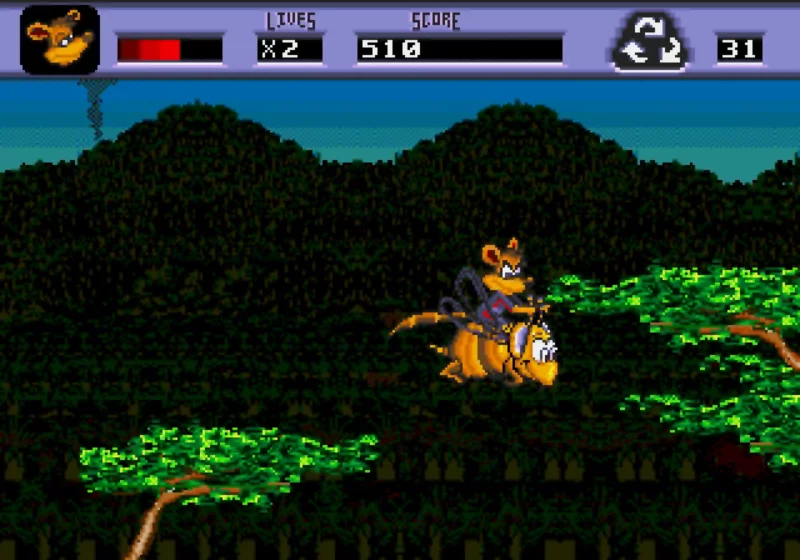
The ironically-named Awesome Possum.
Read more: Konami employee arrested for fire extinguisher attack on boss
Playing possum
The true awesome possum of the 16-bit age wasn’t North American-born, but Japanese: he was Sparkster, the wonderful creation of Konami, whose debut title, Rocket Knight Adventures, was released 30 years ago this month in August 1993.
What actually is an opossum/possum (both are just alternative spellings of the same beast)? When Konami, flicking through their My First Big Book of Animals in search of a potentially best-selling mammal who had not yet been co-opted by another developer, landed on the page marked ‘OPOSSUM’, they would have found that they were tiny rat-like marsupials native to the North and South American continents, some of whom have prehensile tails allowing them to dangle down from branches like enemy spiders in many a 90s platformer. This sounded good to Konami, meaning the in-game Sparkster can slide along, climb and hang down from branches, wires and poles too, which proves most enjoyable.
Real-life opossums are better known for playing dead and emitting horrible corpse smells to deter predators than for attacking them, however, so Konami equipped their own new pet with a special steam-punk sword that could fire out short projectile slash-beams, a flaming jet-pack for him to fly and boost about with, and a chunky suit of metal armour to protect his otherwise vulnerable hide – bright blue, just like the outer carapace of a certain well-known hedgehog. Sparkster never intentionally plays dead in the game, however: he simply has this status repeatedly forced on him by the incredibly high difficulty-level.
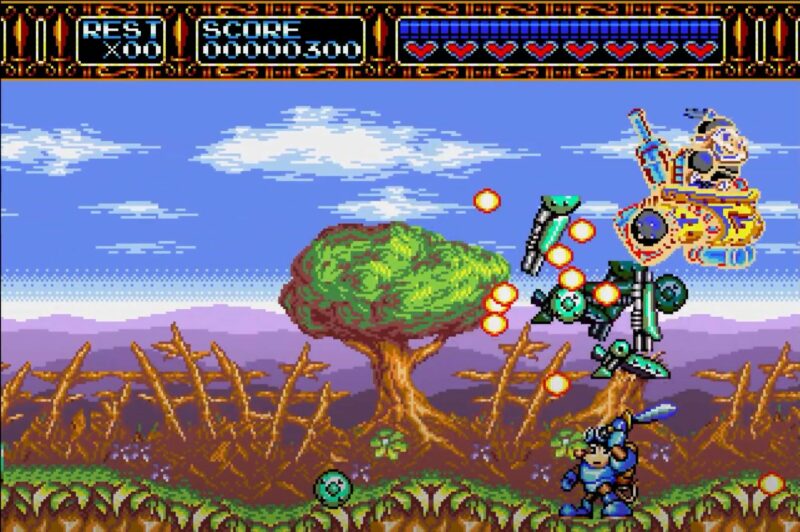
Pig-slashing action in Rocket Knight Adventures. Credit: Konami.
What’s the game actually about? Well, British hardbass musician Alan Aztec has repurposed the game’s excellent soundtrack, co-composed by female Japanese pop star Aki Hata, into a dance tune entitled, simply, ‘Rocket Knight’. Here, Mr Aztec has overlaid Hata’s work with his own lyrics, such as “FIGHTING PIGS ON BIG ADVENTURE/BIG BOSS ROBOT WILL SURRENDER!”
This is actually quite an accurate summary of the title, which strongly resembles a cartoon, kid-friendly variant of Konami’s earlier classic SNES run-and-gun platform-shooter Contra III/Super Probotector, but with weapon-wielding enemy pig-people rather than slimy aliens; both are filled with short, action-packed stretches of platforming interspersed with inventive set-pieces and a never-ending stream of bosses, the majority of whom are bio-mechanical in nature.
This should be little surprise, as Contra III was the immediately preceding 1992 project of Nobuya Nakazato, who also acted as director and chief designer on Rocket Knight Adventures; his next project was the 1994 Mega Drive version of Contra Hard Corps. Thus, Rocket Knight Adventures was essentially Contra: Cartoon Capers, with many of its bosses, like the living train with spindly skeletal arms, red eyes and a gun for a nose, looking just like anime-ified versions of the earlier series’ alien enemies.
Where Contra had speedy forced-scrolling levels in which characters hung onto the bottom of missiles, Sparkster’s own adventure had sections of similar exhilaration in which the opossum shot through chicken-coops on a tiny one-wheeled cross between a minecart and a unicycle, or fought his arch-rival Axel Gear, the traitorous Black Rocket Knight, in a giant mech-suit boxing-match, Goemon-style.
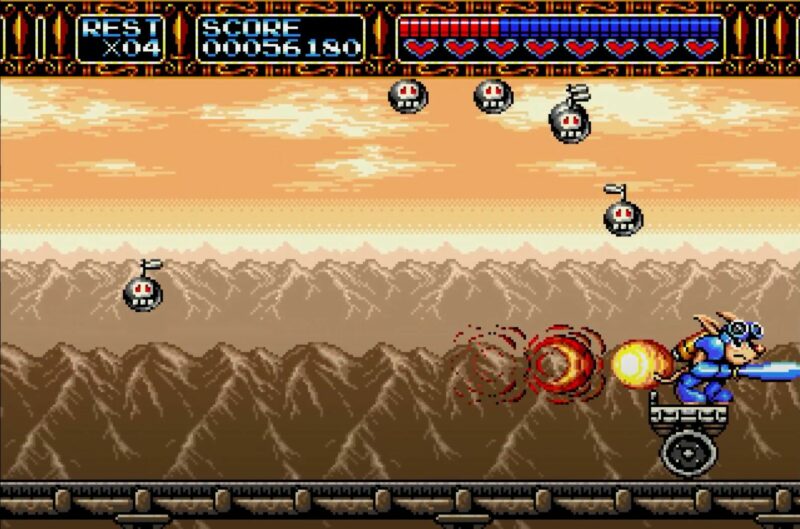
Read more: Mystical Ninja | The Goemon games Konami never bought to the west
Sparks(ter) will fly
Another leading Konami franchise referenced was Gradius, as at certain points Sparkster fired his jet-pack temporarily up into perma-fly mode and shot through a side-scrolling 2D shoot-‘em-up level just like the Vic Viper space-fighter in days of old. In short, the general impression the player gets is of never knowing quite what’s coming next (other than probable death).
In the first level alone, Sparkster takes on a platoon of pig-soldiers in a burning village, falls down a waterfall in a pitched battle with a fire-spewing tank shaped like a hog’s head, fights a giant mechanical flying sea-snake in Gradius mode, crashes through an external castle wall, boosts up its internal castle-walls like a living pinball using his jet-pack, is subjected to assaults from a huge unseen flamethrower, opens a booby-trapped present only to find a killer pig with a sword inside, fights a huge caterpillar-robot which vomits exploding metal spiders, and arrives on the battlements just moments too late to prevent Axel Gear from flying away with the castle’s kidnapped possum-princess in tow on his purple pig-snouted spaceship. The game is nothing but one enormous linked set-piece.
Graphically, the game is exceedingly impressive, with bright colours and parallax aplenty; Konami’s coders managed to include screen-warping effects which somehow successfully ape the SNES’ proprietary Mode-7 method, which seemed like witchcraft. Sparkster switches between background and foreground planes in one level seamlessly, only being detectable by his shadow behind a pouring waterfall.
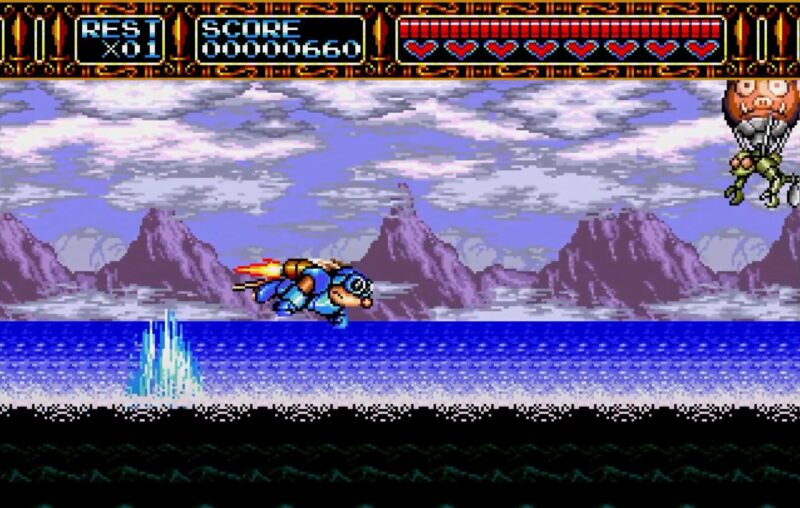
Sparkster takes to the skies for some Gradius-style shooter sections. Credit: Konami.
Elsewhere, a layer of impossibly shiny lava combines with overhanging stalactites which obscure your path to ensure the only way forward is to play the game temporarily upside-down by controlling Sparkster’s inverted reflection rather than his rock-hidden actual body; this not only looked great, it was fantastically original, although it has since been shamelessly copied by others.
Unlike dire western Sonic-clones, Sparkster was designed in an anime-influenced way, and looked ridiculously cute and heroic on-screen, while the way the pig-soldiers shed their shattered armour then expired in embarrassment dressed in only their big white Y-fronts possessed real slapstick humour. Axel Gear, too, proved a worthy arch-nemesis, while inventive boss-design, like the haunted TV-set-thing with the face of a pig-demon on its screen and giant metallic spider-arms which chased Sparkster through outer-space and down back to Planet Possum in his escape-pod before burning up in the atmosphere at the game’s climax, were spectacular.
Sparkster controlled precisely as you’d expect him to and, the occasional jet-pack malfunction aside, the game played like a dream. If you let off your rocket-pack in the right way, the possum would even perform a deadly, on-the-spot spin-move – you know, just like Sonic.
Konami clearly had big plans for Sparkster. On the front of the US box, customers were urged to “Order your official Sparkster T-shirt”, while the back cover boasted, “INTRODUCING THE MIGHTIEST MAMMAL EVER TO ROCKET TO STARDOM”, implying Sparkster’s future status as the next Sonic Superstar was already assured. Telling of how the opossum would face “the hugest, strangest, enemy pig-creatures imaginable” outside of a Lizzo concert, PR wordsmiths urged players to “grind those pigs into sausages” with their sword. Sparkster was a “heroic jet-pack jockey” with a “pumped-up personality”.
With Sparkster, Konami sounded certain they had a sure-fit hit on their hands. He even got his own short-lived strip in Sonic the Comic.
Critical opinion seemed almost unanimous that Rocket Knight Adventures was one of the best games on the Mega Drive; possibly even better than Sonic. Accordingly, two ultra-quick sequels were rushed into production, for both Mega Drive and SNES (although the planned SNES conversion of the first game itself never happened, sadly).
Read more: Mega Drive | The indie dees still making games for Sega’s 16-bit console
Lacking some spark
So, what went wrong? The same thing that went wrong with Sonic, basically: the sequels. Nobuya Nakazato wasn’t involved with either, being too busy overseeing real Contra games instead. The next two titles, confusingly, were both called Sparkster, and had the exact same cover art (and a shared soundtrack). The SNES Sparkster, appearing in September 1994, was very good, being essentially the same as the first game but with new levels and the pig-people replaced with a rival wolf-army under the control of the fascistic military dictator Generalissimo Lioness.
SNES Sparkster was filled with yet more wonderful set-pieces, notably an entire level centring on Sparkster piloting a series of bucking, laser-breathing, fast-speeding robot ostriches. There were no Gradius levels this time, but a vertical-scrolling overhead shooter where the opossum took on a colossal space-battleship like a sci-fi 1942, culminating in another mech-suit boxing-match with Axel Gear. The level set atop a land of giant musical instruments overseen by the dastardly Axel sitting in front of a pipe-organ playing sinister church-music was also great, as was the unusual pyramid-maze stage, with its triangular sliding alternate paths. Yet all this was interspersed with much longer interlinking stretches of slightly banal platforming which slowed down the pace somewhat. It was still a really good game, just not a truly great one.
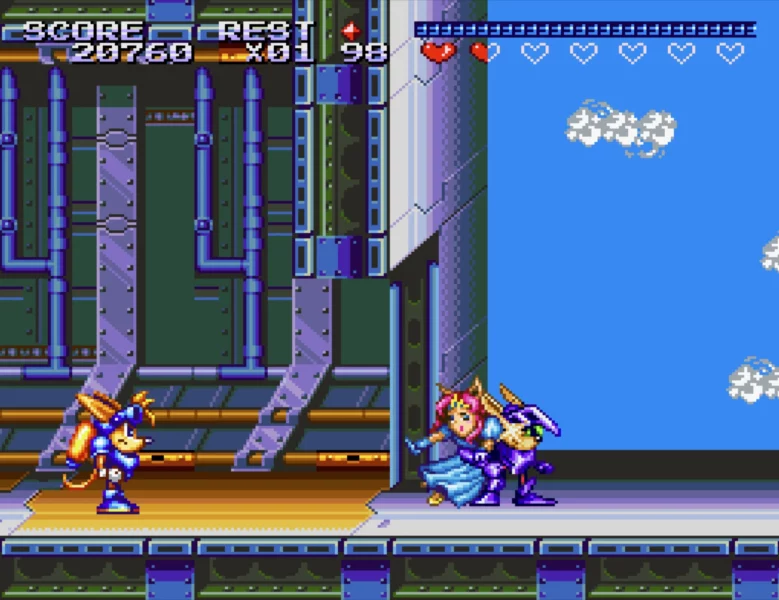
Not a classic, but still has some spark – it’s Sparkster on the SNES. Credit: Konami.
As for the Mega Drive Sparkster, however… The game was evidently a total rush-job, hitting US shelves as soon as February 1994, a mere six months after the original. Graphically, it now looked more like a souped-up Master System game than the lovely original, while the level architecture had been altered to make it more exploration-based and thus slower-paced, thereby removing the major part of its whole speedy appeal. The pigs were replaced by green lizard-men; Sparkster’s newly self-charging rocket-pack was inferior, and he couldn’t fire projectile-slashes from his sword. Sparkster did have spikier hair, though, and thus much more alleged ‘attitude’, which was what was really important here. His old look was much better, as was his old game.
It seems as if, in their over-eagerness to exploit their initial great creation, Konami foolishly just diluted it, and tarnished his brand. Presumably, unlike Sparkster’s great debut, his subsequent appearances just didn’t sell that well. The marsupial did make one final comeback, in 2010’s Rocket Knight, a 2.5D adventure created by external developer Climax, with Sparkster himself unappealingly redesigned along more Western lines, but it didn’t make too much of a public impression.
None of Sparkster’s 1990s outings have made any appearance on Virtual Consoles in the decades since; his 30th birthday provides an ideal excuse for Konami to finally put this right. Or, even better, how about making a surprise reveal of a brand new Rocket Knight game, this time headed up by its true creative genius, Nobuya Nakazato? You never know, Sparkster might not be completely dead – he could just be acting that way. He is a possum, after all.


